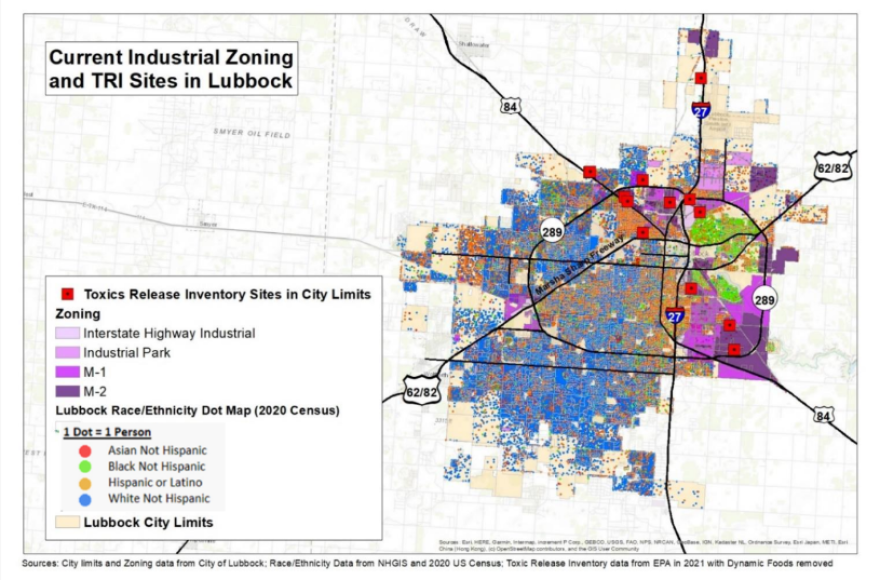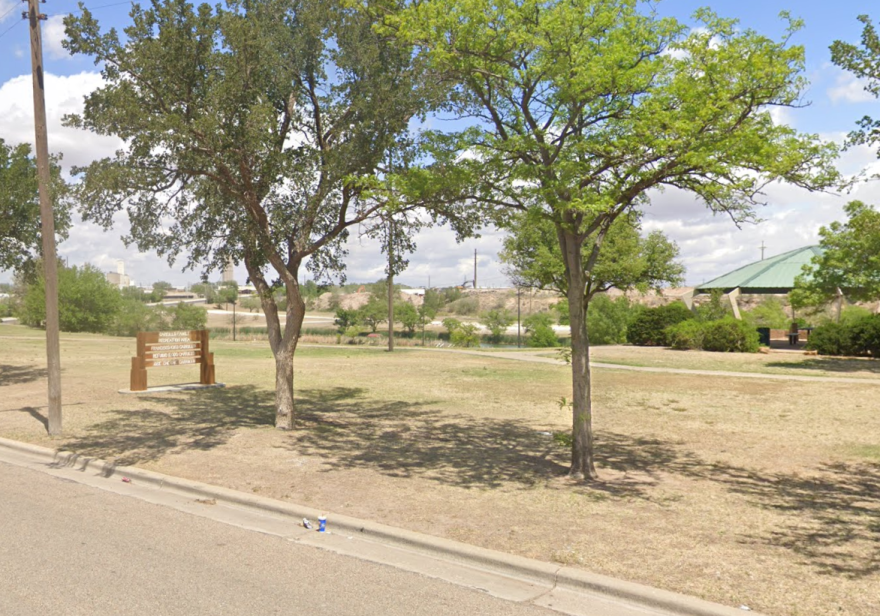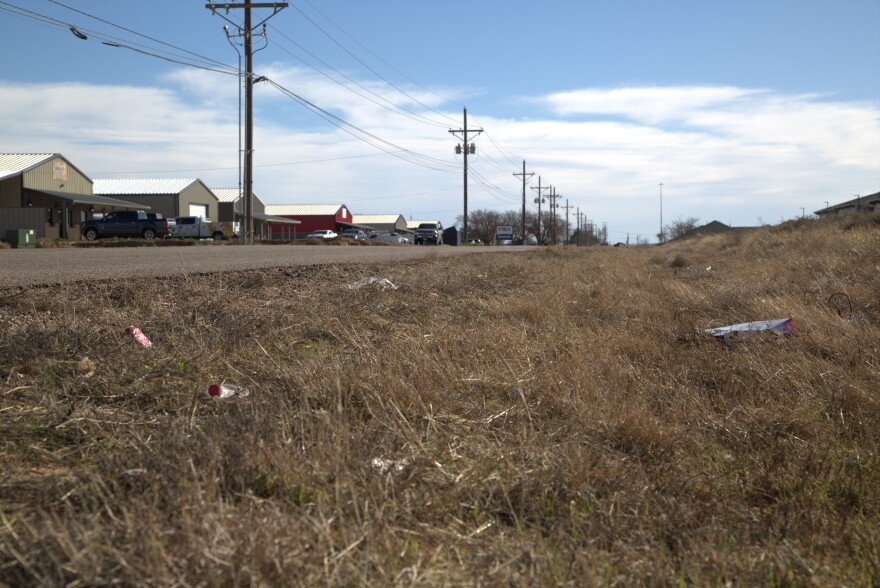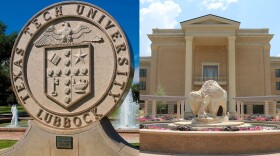At February’s monthly meeting, Lubbock’s Planning and Zoning Commission reviewed a zoning change proposal from the city to shift property in southwest Lubbock from 70 acres of single-family residential space to an industrial park.
City officials told the commission the city council has already approved $17.2 million in funding and planning has long been underway for what the city intends to be a 36,000-square-foot solid waste transfer facility near 76th Street and Alcove Avenue, next to the Marsha Sharp Freeway between Lubbock and Wolfforth.
This facility would serve as a dropoff point for trash trucks on a quickly expanding side of town.
Assistant city manager Erik Rejino told the commission Lubbock’s trash collection currently requires four hours of driving back and forth for every truck, every day, to empty at one of the city’s two landfills outside Abernathy. This takes away from the time needed to pick up trash from the neighborhoods.
“We understand we have an efficiency issue there. So that's one thing we're trying to address as Lubbock grows. It's really important. We've had tremendous growth in southwest Lubbock and other parts of Lubbock as well, we're starting to see it all around,” Rejino said. “There's a pretty significant benefit to the project. The addition of a transfer station will cut travel time to minutes, not hours.”
In an almost standing-room-only assembly at Citizen’s Tower, residents from Lubbock and Wolfforth got up to speak to the Planning and Zoning Commission.
“As a primary care physician who's lived in the community for 10 years, I have concerns about the health and safety of the neighbors, and specifically of the school children related to this dump site,” one resident said.
Frenship ISD Superintendent Michelle McCord suggested the commission vote against the change.
“One of the things that parents, that communities do is they entrust the lives of their children to us, and the learning,” Dr. McCord said. “But part of that is safety. And you can't learn if you're not safe.”
Some residents were worried about the traffic on surrounding roads like Alcove Avenue, and whether the size, quality and safety of the roads could support the addition of so many large vehicles.
The potential impact of this kind of facility and zoning on nearby property values was another concern. Other citizens suggested different neighborhoods in Lubbock could be “better suited.”
“Put the trash plant over there at Mackenzie Fields. I mean, I get it, we don't get a lot of rain. And it’s not irrigated. But I mean, it's pretty trashy over there on the east side of town,” one resident said. “It would be nice to see some other things improved and leave the nicer areas alone and put these other places outside of the city limits or put it on a part of town that’s already got problems.”
Another citizen suggested moving it further to the north of the city would make trips to the landfill more efficient.
“If we have to have a transfer facility like this, and the ultimate destination for that refuse is to the north, what sense does it make for everything to be pushed to the southwest?" One citizen asked the commission. "The facility should be to either the center or north of center, instead of going to the southwest, and then back up to the north.”
The city is expecting two to three trash collection trucks every 15 minutes at the facility, dumping what they collect from neighborhoods into long-haul 18-wheelers that will then carry the trash from the transfer station to the landfill. Collection trucks will be washed before leaving the completely enclosed station to return to neighborhood routes.
“We want to make sure that what we build is a quality facility,” Rejino said. “We want to make sure that when folks drive by this that, really, you shouldn't even tell what it is.”
Public Works Director Wood Franklin told the commission the current site is as close to the center of the city’s growth as officials could find with enough space to allow for buffer zones and traffic access for the trucks.
“One of the main factors is we want to be at what we call ‘the waste centroid,’ which is really the center of Lubbock,” Franklin said. “Our main goal is to be at the middle of all of these routes, so it's more efficient for those trucks and not having to spend less time off of the routes picking up trash. That was one of the main factors. Obviously with utilities, size, finding seventy acres in the center of town is very difficult to find.”
Commission member Brandon Hardaway said he lives on the southwest side of town and he shares the concerns for the health and safety of his neighbors, but he also noted the suggestion of moving the facility to north or east Lubbock reflected a level of irony, in light of years of input from residents of those neighborhoods.
“I resent that notion to just dump this on the east side of Lubbock or put it in the north side of Lubbock,” Hardaway said. “There was certainly some innuendo of ‘don't put this in my neighborhood, put it in a less desirable, already trashy part of town.’ I resent that.”
Susan Tomlinson with the Planning and Zoning Commission noted whether people live on the west side of Lubbock or the east side of Lubbock, families will never want this facility nearby, but they will benefit from its services.
“Nobody wants trash in their backyard. But they also want the trash to go away from their back alleys. And they want it to go somewhere, they just don't want it to go in their own backyard. They just want it to go far away," Tomlinson said. "But then they also want to save money and be efficient. And so what we have here is an imperfect situation. And we're going to have to come up with a solution.”
This dichotomy of what constitutes a benefit to the city and how it could affect residents as the city grows is not a new conversation in Lubbock.
Since 2021, discourse over what the new Leprino Foods mozzarella cheese plant will mean for the city has sometimes reached heated levels.
Representatives from Leprino Foods and the Texas Commission on Environmental Quality met with residents when it became known that the factory will be releasing thousands of gallons of wastewater per day into Lubbock’s historic Lake Dunbar.
City officials and Leprino representatives emphasized what the addition of 600 new long-term jobs could mean for the community, while the TCEQ, the same government organization that would regulate the city’s garbage transfer station, insisted “existing water quality uses will not be impaired” by the factory’s waste.
Meanwhile, east Lubbock residents expressed frustration that these industrial facilities continue to be placed near their homes. But Leprino said it makes sense for efficiency, being “closest to the cows.”
Controversial zoning in Lubbock is almost as old as the city itself. In 1923, some regulations were established with the stated intention of keeping Black and Latino Lubbockites away from white residents by restricting them to neighborhoods closer to industrial areas. Over 100 years, the wording of some rules have changed, but generations of citizens still live near industrial facilities that they say continue to have harmful impacts on their health, property values and quality of life.
In July 2023, after the Lubbock city council passed the new unified development code without making significant changes to the zoning map, a coalition of residents from North and East Lubbock, with help from attorneys with the nonprofit LegalAid of Northwest Texas, filed a complaint to the federal department of Housing and Urban Development against the City of Lubbock, arguing current zoning and the impacts on Lubbock citizens constitute a violation of the Civil Rights Act.
At a recent forum on environmental justice, a panel of representatives from the North and East Lubbock Coalition and LegalAid spoke to the community about their complaint.
Adam Pirtle, an attorney with LegalAid, told the assembly “it’s about following the money.”
“The City of Lubbock gets a lot of federal dollars every year, city council directs where those monies go. And therefore, city of Lubbock has a Title VI duty to make sure none of their programs and activities, including zoning, are discriminatory,” Pirtle said.

The panel spoke on facilities in years past that have been close to Lubbock schools and neighborhoods, sometimes forcing temporary evacuations from those neighborhoods because of leaking hazardous chemicals, like the Gandy’s Dairies facility in 2007 and the Arctic Glacier facility in 2009, both involving spills of anhydrous ammonia.
A 2013 spill of hydrochloric acid in north Lubbock at Bayer CropScience forced about 20 homes near Erskine Street to evacuate and another hydrochloric acid leak at a facility in southeast Lubbock in 2019 also prompted evacuations.
In 2022, emergency crews responded to a hydrochloric acid spill at Cotey Chemical Corporation (Triple C) near 44th Street and MLK Boulevard.
North Lubbock advocate Dora Cortez is a sixth-generation citizen of Lubbock from the Guadalupe neighborhood. At the forum, she spoke of facilities like the concrete batch plant that can be seen from her kitchen window, and PB Materials concrete mixing, just down the street from a nearby park.
“If you've ever been on Erskine on the other side of Avenue Q and seen the mounds of debris and stuff that they have piled up there,” Cortez said. “And right south of that facility is lake number three.”

Reform supporters have called for strategic down zoning and the process of amortization to be incorporated into Lubbock’s UDC, to provide a legal method for the city to initiate a timeline for “non-conforming” facilities and blighted buildings in rezoned areas to shut down or move.
Pirtle said it’s not just the health issues that residents living near industrial zoning have to worry about.
“It's a pretty neat comparison where there is industrial zoning, there is lower property values,” Pirtle said. “If you own a home and you want to transfer that home on to the next generation, you're not going to have as valuable a property as you would if you owned a home in a different part of town.”
In October 2023, Lubbock’s city council decided to organize a citizen committee to “assess the extent and negative effect, if any,” of industrial structures on neighboring residents in Lubbock, and to review strategic down zoning as a possible tool.
After four meetings over two months, the committee returned to the city council saying no action should be taken when it comes to implementing amortization.
The committee presented Texas Senate Bill 929 as a state law that has already provided strategic down zoning methods for municipalities, and Lubbock incorporating amortization methods into the development code would be in conflict with this legislation. Signed into law by Governor Abbott in May 2023, part of SB 929 requires municipalities to pay back businesses that are declared to be non-conforming after down zoning, as opposed to the possible fines that could come with amortization processes.
Thomas Parker, the general manager at Gandy’s Dairies in Lubbock, served as chair of the amortization committee.
At the start, the committee was hard-pressed to define what their goals should be, but members were quick to note where flaws could be found in Lubbock’s zoning. Parker highlighted one example to the city council where parts of the Preston Smith Airport remain zoned as residential areas.
“That's a real black-and-white example of how the zoning should be looked at,” Parker said. “Now, whether or not that's going to change the world, I’m not really going to step down that line, but I'm telling you, by the rezoning process, it needs to be taken into consideration.”
The committee voted 3 to 2 against recommending the incorporation of amortization processes in the development code but voted 5 to 0 in favor of a zoning map analysis by the City of Lubbock to narrow down where other flaws could be.
“So you, you consider that there was a negative effect and this is how you chose to address it? Is that correct?” District 3 representative and mayoral candidate Mark McBreyer asked.
“Yes,” Parker replied. “We're recommending that the rezoning, those other questions and those answers would come through that rezoning process.”
City Manager Jarrett Atkinson pointed out that while a zoning map analysis could indicate where issues are, making changes would still fall under normal zoning procedures, with the reminder that only the city or the owner of a property can initiate their own zone change.
“I'll give the council one of the examples your committee heard: there's a significant number of city-owned parcels that are zoned for heavy industrial uses. We have some parks that have GI (General industrial) or LI (Large industrial) within them," Atkinson said. "That's not appropriate. Zoning map analysis calls those out but whether 'it's leave it alone' or down zoning, any change now goes into the full zoning process. It gets submitted to the Planning and Zoning Commission, their action recommendation, then ultimately to y’all.”
Adam Pirtle said he felt like the real questions and answers were avoided by the committee’s conclusion, but things can still change when it comes to zoning issues in Lubbock.
“I'm disappointed that even though I think we all know that the north and east side obviously are the most impacted by this stuff, and have to deal with this on a day-to-day basis, that the city doesn't want to hear that answer,” Pirtle said. “I'm hoping that as we move forward with this process, that we take a more honest look at this, and we start looking for a solution that's going to help the neighborhoods on the north and east side.”
Natalie Miller with the North and East Lubbock Coalition said the committee’s decision on amortization was not surprising, but while she may be down, she isn’t out.
“Unfortunately, it was expected. I was hoping for something different, that there would be an actual attempt to make necessary change,” Miller said. “But I am encouraged because that's just one situation, right? What we're doing is so necessary, that that can't deter us from the ultimate goal, which is to have safer, healthier communities.”
As for the city’s possible waste transfer station, the planning and zoning commission voted to approve the zoning change with a vote of 6 to 3. City council is expected to discuss final approval on Tuesday, February 13, at 2 p.m., at Citizen’s Tower.
A federal grant from the Environmental Protection Agency was issued to community group Lubbock Compact to study air quality and particulate matter from industrial facilities, and their effects on residents’ health. The organization is now looking for citizens interested in hosting a monitor to provide data for the study.
An application form can be found here.
Meanwhile, the City of Lubbock Community Development Department and Lubbock Housing Authority are calling for input from citizens to develop their 5-year plan. Federal funding programs intended to “address affordable housing and community development needs” carry requirements from Housing and Urban Development to receive them.
The Community & Fair Housing Survey can be accessed here, and will be taking data until March 1.
Copyright 2024 KTTZ 89.1FM. To see more, visit KTTZ 89.1FM. 9(MDA4OTAxNzAzMDEzMjc0MTc2MzA5ZDZlMw004))







